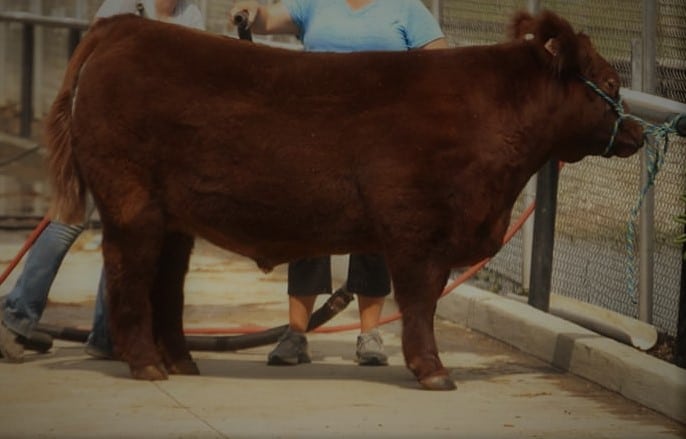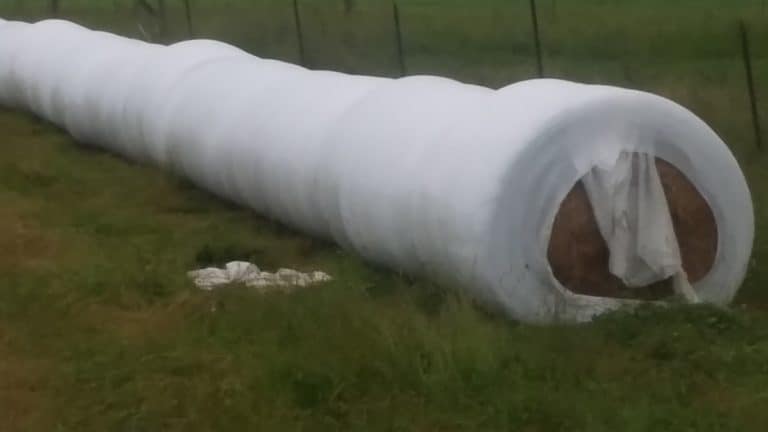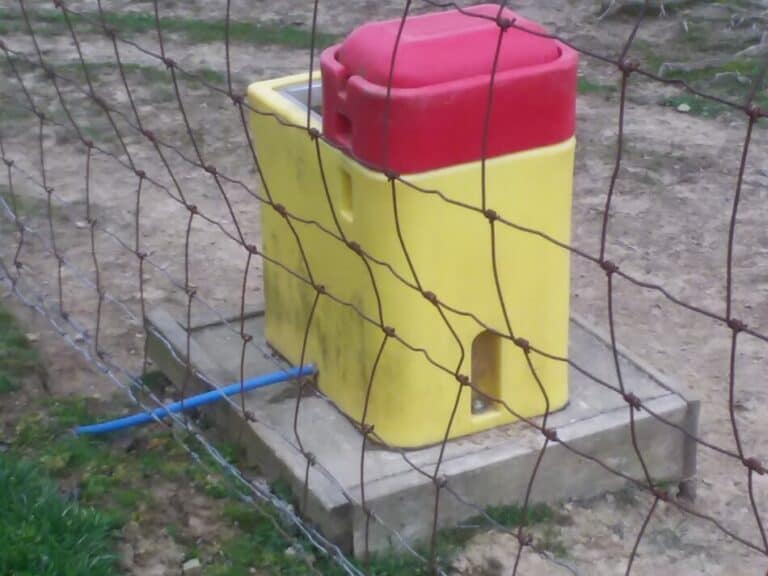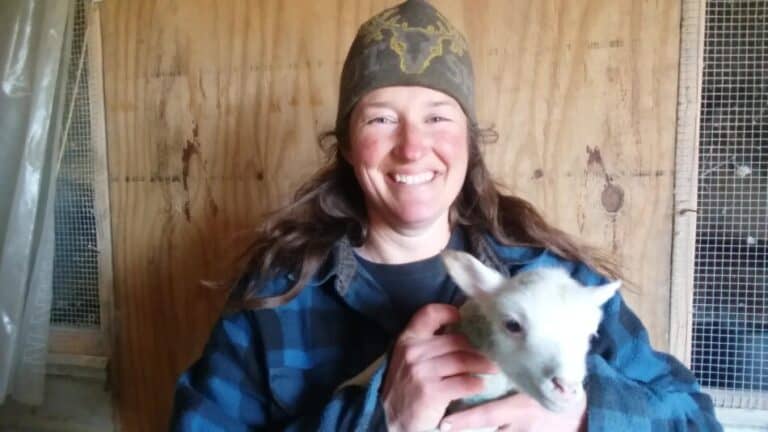Raising Farm Animals Together: What Works And What Doesn’t!
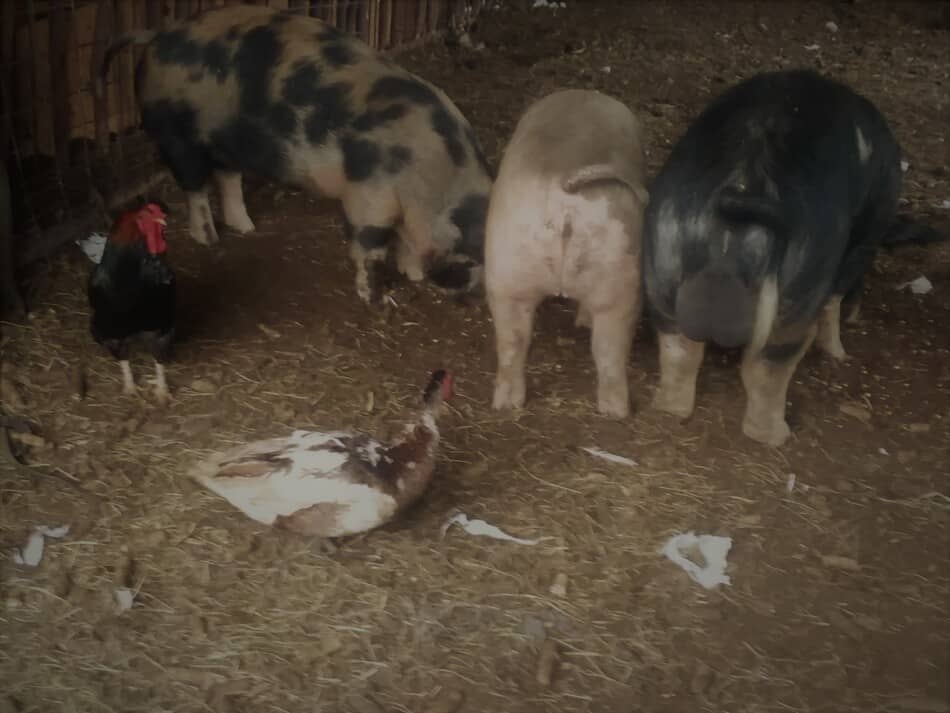
Multiple species of farm animals can be successfully raised together. Other combinations seem like a good idea, then don’t work!
Farm animals that can be successfully raised together are ruminants (cattle, sheep, goats) and poultry, pigs and poultry, mixed ruminants and mixed poultry.
If you are looking to raise multi species together, the best combination to start with is ruminants and poultry.
Of course, there are a few other combinations that work very well and some that are a disaster! We’ll get into the details below.
4 Low Maintenance Farm Animals is a selected list of the animals we have noticed that take the least daily care.
Considering raising your own meat this year? Read Cheapest Meat Animal To Raise for a cost comparison, based on pounds of freezer ready meat, between common meat animals.
Animal combinations that work benefit each other
Animal combinations that work are ones in which both (or all, if you are combining more than two) species naturally work with the other.
Think of the animal combinations you might see on a nature video.
Combinations that work best feature animals that benefit from being close to each other, but don’t directly compete with each other, especially for food.
Remember: in the animal world, might makes right.
What does this mean to you? If the animal you don’t want to have the resource (feed, water, shade, etc.) can get it they will, even if it’s not supposed to be theirs.
Same goes for “sharing”. Most animals don’t share, they pig out and take what they can before the others get there or run off the more timid ones and take the resource. This isn’t being mean, it’s being normal. It’s your job to separate them if being together is not working.
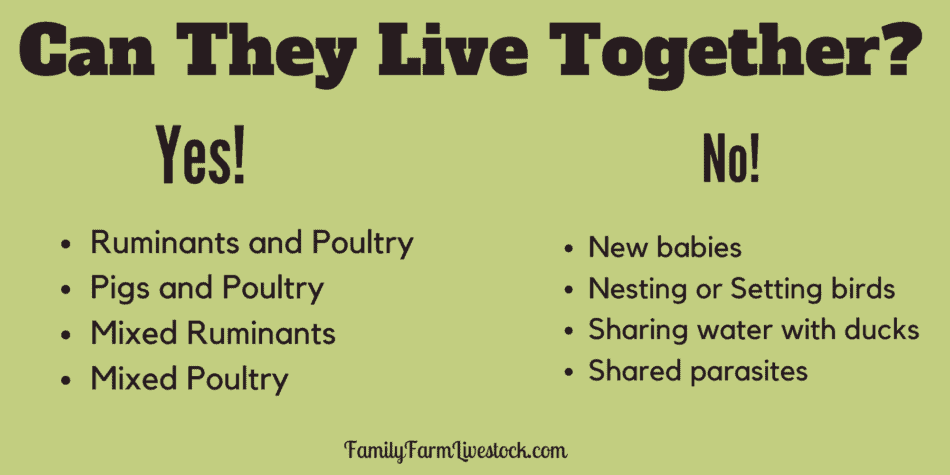
Ruminants and poultry work well together
Nearly any ruminant (animal that chews a cud, think of a cow or sheep) will benefit from being raised with poultry.
Why? It’s easy when you think about it, look at what each animal will gain from being with the other.
Ask yourself, what does the ruminant want? A nice pasture to graze, no flies or parasites and plenty to eat. Will the ruminant get what she wants if she lives with chickens, for example? You bet!
What does the chicken want? A nice pasture to peck around in, safety from predators and plenty to eat. Living with a herd is great for chickens, they get it all!
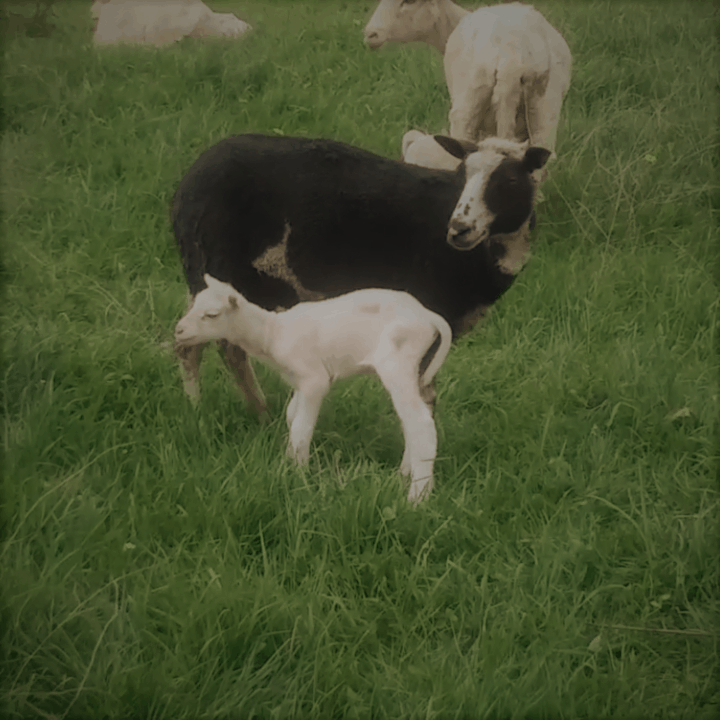
For example if you were to put sheep and chickens together, they would both benefit.
There would be little to no competition between them, since the sheep are mostly eating grass and the chickens are mostly eating bugs (and some of the more tender grass).
Both the sheep and the chickens would benefit from being together by the chickens eating bugs, especially flies, and the sheep making a predator like a hawk or fox, rethink the plan of swiping a chicken!
Common ruminants would include all ages of sheep, cattle and goats.
Common poultry would include chickens, ducks and geese.
Pigs and poultry can and should be raised together
Pigs and poultry work well together!
I know there is some information available stating you need to keep birds out of the pig area, but in my experience that is not the case.
Our birds run into the pig pens all of the time and, generally, the pigs don’t care a bit.
(I do have to admit, the older pigs, sows or boars, will get ahold of a bird if they feel like it. Usually, they don’t bother, but it can happen.)
Poultry do a great job of cleaning up spilled grain, especially if you are using a bulk feeder!
If you have chickens, they will scratch around and eat any bugs or maggots that are starting to grow in the pen, less flies for you and your pigs!
Can Pigs Be Raised With Birds? gives you the details on keeping your porkers with your poultry.
Ducks will make a mess of open water
If your pigs are getting water in a pan or trough and some of the poultry you are speaking of are ducks, you will have ducks in the pig’s water, plan on it.
Generally, this is not a big deal for pigs but it will require you to dump out the water and refresh it fairly frequently, since ducks poop wherever and whenever, including in the pig’s water!
A potential easy fix here is to keep the pigs on nipple waterers and give the ducks a pan of their own. This works well until you get into freezing weather, but a partial solution is better than none!
Word to the wise, if your ducks are Muscovy, they can and will fly, which gives them an extra ability as far as accessing water you’d rather they stay out of.
Baby poultry should not be kept with pigs
The main caution regarding pigs and poultry is if you have hens (ducks or chickens) with babies, the mom will run into the pig area at feeding time, yes, she’s watching!
No worries when she goes in the pen, but sometimes the babies do not notice when she leaves and one or two of the ducklings or chicks will get left behind in the pig pen.
Unless the mom is a superstar, the cats will get that unattended and chirping baby before the mom can get back to it.
The common worry seems to be that the pigs will eat the birds. Of course, they are more than capable of eating the poultry, but they don’t.
Pigs would rather eat their feed then go take a nap rather than spending the energy to hunt down a moving target, it’s a lot more effort!
I’m referring to full sized pigs in this section, but smaller or even mini pigs would also get the same benefits from having poultry around their pen or in the pasture cleaning up spilled grain and eating bugs.
Mixed ruminants can be raised together
The beauty of mixing ruminants, like grazing cattle and sheep together, is you get to have more animals on the same acreage for the same or nearly the same time as having one species.
For example, adding a few sheep to your cattle, or the other way around, will make more animals on the same acre with little difference in timing of the pasture moves.
Meaning adding a few sheep will not make the cattle run out of pasture any sooner than before the sheep were with them.
Adding a bunch of sheep will have the grass eaten sooner, of course. However, a few sheep added to the herd will be hard to notice, grass/eating wise.
Choose animals that do not have parasites in common
Another plus is you get to raise more animals for the same acreage but do not pass the parasites back and forth between them (except for sheep and goats).
Any cattle specific parasite eaten by a sheep does nothing to the sheep, yet is no longer around to infect other cattle. The same goes for sheep parasites in cattle.
Choose to add animals that eat slightly different forages
Another option to consider, if you are starting with cattle is to add some goats.
You will notice that the goats prefer a different type of diet than the cattle, more of a browse selection, like briars and leaves of small trees and shrubs.
Chances are your cattle weren’t doing a great job eating the browse in your pastures, since they prefer the grass or hay type plants.
With the addition of goats, things will be different! The goats will pick around at the grass, but they really are after the browse.
A bonus for you, since your cattle weren’t eating it anyway!
Fencing needs will be different for each species
You will need to have the fence that keeps in your harder to keep in animals. So for cattle and sheep, the fence needs to keep the sheep, for cattle and goats, the fence needs to keep in the goats.
A caution with fencing: for goats, fencing will be an issue. The fence that easily holds in cattle will be nothing to a goat.
For sheep, it’s not as big of a deal but it will still need to be more substantial than what the cattle need.
We have both, but mainly sheep, a few goats and a few cattle and all on electric netting.
The netting is not for the cattle! Netting works fine and the cattle respect it well, but for them it’s overkill. The netting is for their short buddies!
Read Add Diversity to Your Pastures with Multi Species Grazing by Lee Rinehart to learn more about the pasture and farm wide benefits of grazing animals together.
Mixed poultry can be raised together
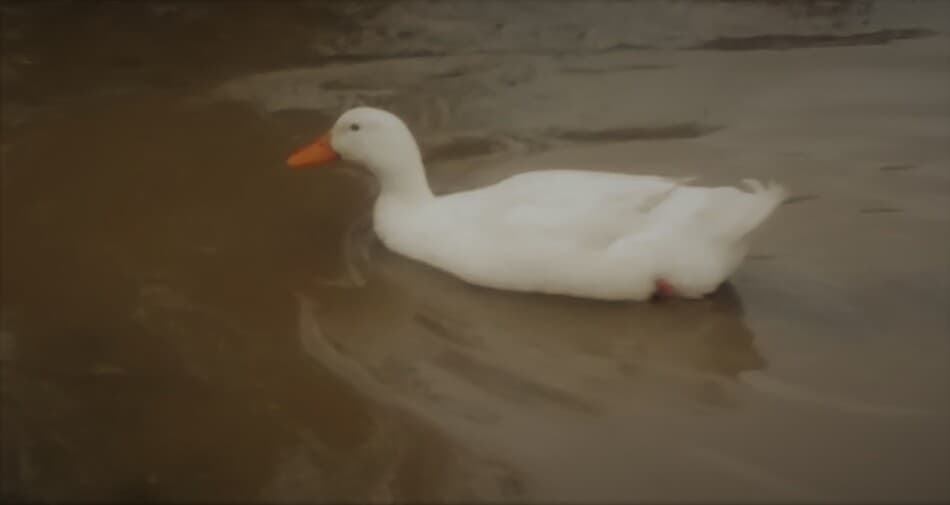
Different types of poultry can be successfully raised together. Actually, we do this all of the time!
The ideal combination here is one where the birds are both looking for different food sources or looking for food in different places.
Having part of the flock be bug eaters and part of the flock be mainly grazers would be ideal.
Here are some examples of what I mean:
- Chickens and ducks-this combination would get you bugs scratched out of the dirt and your yard by the chickens. Any bugs that are using water, like mosquitoes, would be eaten by the ducks.
- Ducks and geese-the geese are going to concentrate their efforts on little plants and grazing. The ducks like little plants, as well, but their main target is little bugs and invertebrates like slugs.
- Loose ducks and broilers (penned)-in this case the broilers are in a pasture pen and the ducks are roaming as they please. When you move the broilers to a new spot, the ducks will come and eat the grain spilled by the broilers. It’s surprising how fast the ducks are at catching on to this “free” food.
Keeping The Peace In A Mixed Species Flock by Kirsten Lie-Nielson is an interesting read if you want to learn more about mixing birds.
As always, remember that ducks make a huge mess with water, both in the waterer, itself and around the waterer on the floor or dirt! Moving them will lessen the mess, but plan for this, it’s the duck way.
Some animal combinations do not work
Sometimes animals that you think will work well together do not. It could be something easy to see, like they don’t get along, even after a few days to get used to the new grouping.
Other times the problem can be harder to spot, for example a potential health issue stemming from sharing common parasites.
This would be seen with slow growth and unthriftiness in a few weeks or months, but not immediately.
Here are a few of the animals that should be kept separate:
- Hatchlings (any baby poultry)
- Nesting or setting birds
- Newborn smaller animals (like lambs)
- Broilers
- Raising anything in tight spaces
- Sharing water with messy drinkers, specifically ducks
- Animals that share the same parasites
Hatchlings should be kept separate until they are very mobile
If you can, keep hatchlings out of the pens of other animals until the hatchlings are very mobile and can avoid getting in the way of the larger animals.
I know that birds have a mind of their own regarding where they should go with their babies. It can be tough to keep those hatchlings safe when they are zooming around with mom.
Larger animals will not hurt the hatchlings on purpose, but stepped on is still dead, even if it was accidental.
To be honest, if a chick or duckling was stepped on by one of your cattle, the steer probably didn’t even notice!
Brooding Ducklings will show you a classic brooder set up, which will be very similar for all of your hatchlings.
We keep a brooder area ready to go all summer. There are always babies, usually ducklings or chicks, that need it!
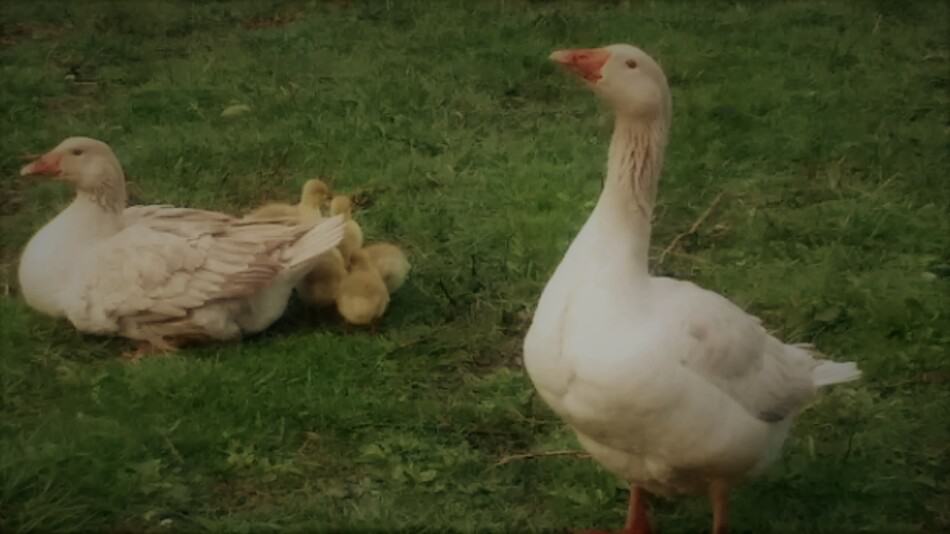
Nesting/setting birds need peace and quiet
A nesting bird needs peace and quiet. Leave her alone and make sure she is out of reach of the other curious animals you have in the barn, as well.
While it may sound lonely to us, a nesting bird needs peaceful and quiet surroundings for the entire nesting period.
She does not want to be messed with, by you or other animals.
Look at the place she chose to put her nest, chances are high that it is out of the way and snuggled into a corner or other out of the way spot.
She’s looking for solitude not to be the life of the party!
The challenge comes to her in the form of curious pigs or frolicking calves or lambs.
Will A Goose Sit On Bad Eggs? gives you a look at nesting geese and their behaviors, at least as we have noticed!
For the nesting mom to do her job, you need to keep all of the potential “intruders” to her space out of her immediate area.
This is the main reason why nesting and setting birds need to be kept separate, it’s not about the bird, it’s everybody else!
Newborn smaller animals need to be separate from bigger animals
Newborn lambs, kids and piglets should be kept separate from larger stock, like cattle and horses.
Until they get their “legs” and are able to run with mom, small newborns like lambs should be kept separate from bigger stock, like cattle or horses.
Once again, I don’t think this is a mean or aggression issue, it’s a not paying attention issue.
The lambs will need a few days to a week to really get coordinated, until then they are easily stepped on by a not so careful pasture companion.
While I am “pro” pigs, I do have to admit, pigs are the potential problem here, especially the adults. Keep all young animals out of the pig pen or you run the risk of the pigs snarfing them up.
Broilers should be raised with separately from other birds
Broilers need to be raised separately from other birds and other livestock.
Putting broilers in the “don’t combine them” section might sound like a point of disagreement with other sources you may have read, but it’s really more of a clarification.
Broilers can be raised on pasture that other animals, like cattle, have eaten down. This is a great idea, since it keeps the grass at a shorter, more poultry friendly length.
So, where’s the confusion? The broilers are on the pasture after the cattle, not with them!
Here’s why: the broilers have special and very specific needs that will be difficult to provide unless the broilers are raised by themselves.
The problem here is that if you don’t meet the needs of the broilers, there will be negative consequences in health and growth, some of which can not be fixed. Keep broilers separate, healthy and on track.
Is Raising Meat Chickens Worth It? will show you how to figure up a budget for your meat chickens (broilers) using prices from your area.
Other poultry will steal broiler feed
Raising broilers with other birds, for example, means the other birds will all eat broiler feed, as well. Yikes, that’s going to jack up your feed costs!
Even if you put out regular chicken feed and broiler feed, they’ll all eat the broiler feed.
Your laying hens will figure out that the broiler pen has great tasting feed and they’ll jump right on in and eat all they want!
This will raise the feed cost for your eggs and could scare the broilers away from the feed for the time that the hens are in the pen.
This is stressful for your broilers, keep the lid on to keep your broilers safe from feathered invaders.
Other taller animals will steal broiler feed
Another detail that may not have occurred to you is that any other animal tall enough to reach over the top of the broiler cage and get to the feed will try it!
Aleene, our family cow, will harass the broilers hoping for a bite of their feed. You can count on goats and a few brave sheep doing the same.
I’m sure you are thinking, just put a lid on the broiler cage. True, but it has one, she shoves it off! She needs to be kept completely out of this pasture as long as the broilers are in it.
Another reason for the lid- all of your other poultry will jump into the broiler cage and sneak some of their high protein feed.
Broilers in a pasture cage grazing after a herd is a super idea. Broilers loose grazing with a herd, bad idea.
Tight spaces are a poor choice for all animals
Anytime the space in an area is tight, you need to reevaluate what you are doing with your animals and change something to make them more comfortable.
Could you move one higher and one lower, but still under the same roof?
For example, rabbit cages over an outside edge of a chicken run area.
The rabbits will have plenty of space and be easier to care for at waist level and the chickens can peck around under the rabbit cages for bugs and dropped feed.
Get Started Raising Rabbits gives you a list of what you need to get going, including costs, with your own meat rabbits.
Could you move a more hardy or less needy animal to an outbuilding and free up some space?
For instance, if you have a new set of chicks and a few mature ducks, but limited space under roof.
The chicks need to be inside in a brooder, but the ducks can stay out overnight, provided you have some protection for them.
You could you put up a very basic shelter for the ducks outside or use a dog house.
A second option would be to brood the chicks up higher, like on a plywood and sawhorse “table” and let the ducks run as normal underneath.
When the chicks don’t need the brooder anymore the arrangement is only altered slightly, now instead of a brooder in the air the chicks need roosts.
Either way you can comfortably “stack” the birds’ space requirements by mimicking nature.
Mixed animals but one water trough does not work with ducks!
Do not plan to have ducks sharing water with any other animals.
It’s going to sound like I’m being a little hard on ducks here, I’m not. I love ducks and get a huge kick out of having them waddle around the barnyard.
And the ducklings are just darling! But and this is a big one, they are messy drinkers! Sometimes amazingly messy drinkers!
And not just spilling water, but that is always their goal! I mean making the water dirty, sometimes poopy, from dibbling around then rinsing their beak.
While this is normal duck stuff, it’s not great for the rest of the drinkers, especially the ones whose manure the ducks where just messing with!
Ducks must be kept out of other animals’ water!
This is especially challenging when companion animal needs a short water trough, like smaller size goats or lambs! Be aware of the duck behavior and frequently dump the water trough!
How do you know if the water needs to be changed? Easy, would you drink it? Didn’t think so, time for fresh water!
Animals that share the same parasites should be separated
Keep animals that share the same parasites separate, if possible.
This parasite transfer back and forth between species does not happen frequently, especially if you are mixing a large animal/ruminant and a bird.
However, some birds will pass parasites around among each other and with the larger stock, sheep and goats pass parasites back and forth.
For example, we have noticed now that we do not have many turkeys, the peafowl are doing better with staying ahead of parasites.
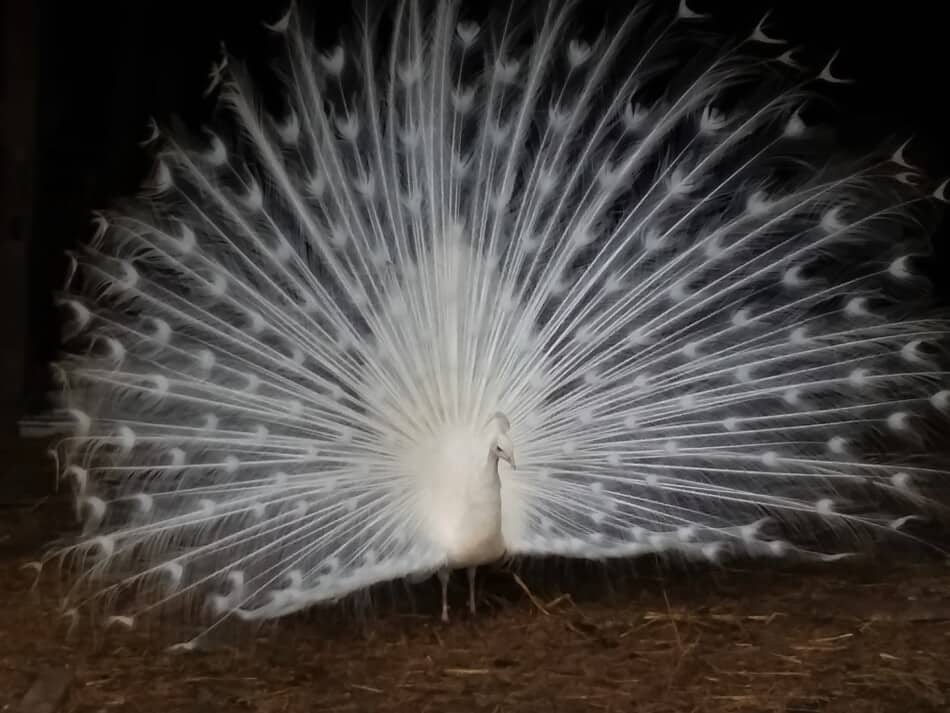
The most common challenge here is sheep and goats, which, as I have mentioned, we keep together.
We are aware of the potential issue and deal with it by making sure the animals have plenty of space and plenty to eat.
Overcrowding and really short grass will promote parasite infestation of both your sheep and your goats. The opposite, space, plentiful grass/browse and low stress will help keep parasites to a minimum.
Sheep or Goats: Which One Should You Raise? walks you through the pros and cons of each so you can see which will work best for you and your farm.
General guidelines for raising multi species together
- Adding different breeds is not a new combination, this is competition for the same resources. This means adding more chickens to your chicken flock is not the same as adding ducks or geese to your chicken flock.
- Give all animals plenty of space, tight spacing increases stress
- Be sure all of the species are getting their different needs well satisfied. For example, if your new goats are happy, but your chickens have become nervous wrecks, something is not right. Start adjusting and tweaking the living arrangements!
- New babies of any species will cause a disruption in groups that would have otherwise been getting along. Keep new babies separate until they are agile enough to keep up with mom.
- Special diets or nutritional needs and multi species raising do not go together well. Keep any animal with special needs, dietary or physical, out of a mixed group.
What about animals on pasture?
Having multiple farm animal species together on pasture is a great idea! Diversity is always a wise decision for a pasture!
Here are a few things to keep in mind when mixing species on pasture:
- Fencing will vary for each animal, make the fence suitable for the most challenging animal in the group. For example, if you have sheep and cattle together on an electric fence, the cattle will be easy to fence, the sheep will be more challenging. If the fence is not electrified, the cattle will be more of a challenge!
- Be sure every animal has access to resources like shade, food, water and windbreaks. The more dominant animals will “hog” the resource and the more timid ones will be forced to go without. Plenty of each resource for all makes this a non issue. As an example, horses will boss everyone, except horned cattle. Most goats will boss the sheep, etc.
- A huge plus of multi species grazing/pasturing is predator control or at least predator inhibition. We have coyotes here and they are not shy about stealing a new lamb in the sheep only pastures. But the multi species pastures seem to make the coyotes look for easier places to find dinner.
Animals That Can Be Raised With Cattle gives you other animal options that will work well with your herd.
What about your herd sire in the non breeding season?
When you have a smaller herd or flock, chances are you are going to have one breeding male.
Where does he live when you need him kept out of the gals to make sure that babies are born at the times you want and not born at the times you don’t?
The best answer here is to put him with a group that eats what he eats or is eating something that he can eat and is in a pen or pasture that will hold him.
For instance: where do you keep your ram when you need him to be separate from the ewes?
This ram could be put with some steers or other hay eaters you have or kept in a pen by himself for a time. Keeping him by himself is a poor option and should be avoided if possible.
When does he have to be removed from the herd/flock?
The first thing you need to do is some math, what are the months that you do not want babies born in? List them out.
Now use a gestation calculator and figure out the last date you are comfortable with having the sire in that group.
Remember to cushion the number to give a late born baby a few months to grow before winter sets in.
For us, we do not want any lambs born from mid November until late April, this means that rams or uncastrated ram lambs, must be out of the flock by late June and they stay out until the first of December.
The specific dates will be different for cattle, pigs, etc. but the basic idea is the same.
How to evaluate if the group is working or not
- Are all of the animals happy and healthy? You should see energetic animals with shiny hair coats (or good feathering) and healthy appetites that are gaining weight.
- There will be squabbles, this is a normal herd thing. Are they minor or is one of the animals living an overly stressful life? If the squabbles have an animal falling behind in growth or always looking depressed, remove it from the group or separate the species.
Always keep in mind what is best for your animals and your situation.
Remember, it will not be the same as what your neighbor is doing or what the folks online in that article you just read are doing.
Raising animals is a constant balance that can be beautiful when well orchestrated, but can be rough when not suited to your area or resources.
Keep the biology/natural tendencies of your animals as the priority, spend time in the field with your stock, observe and adjust as needed.
